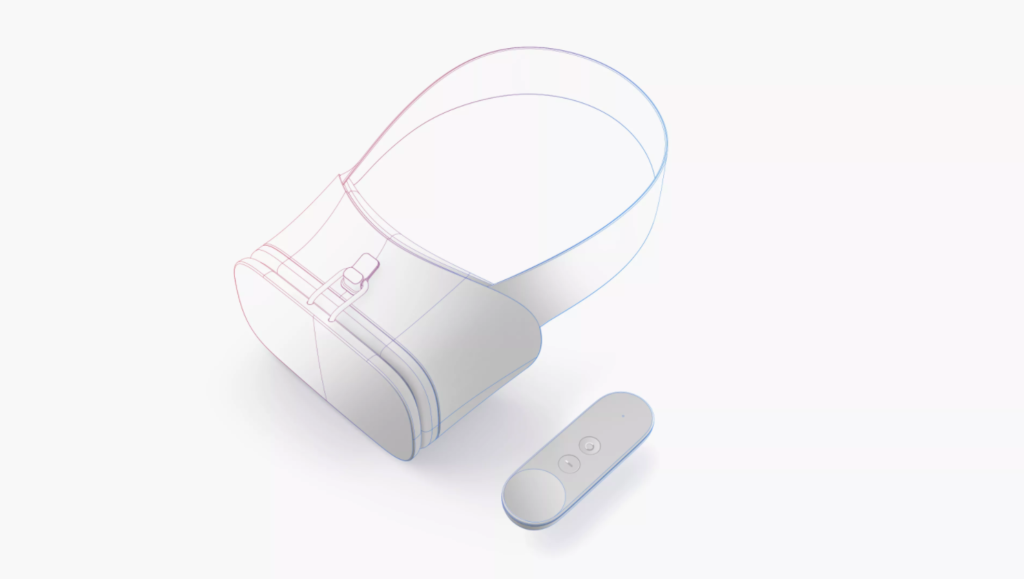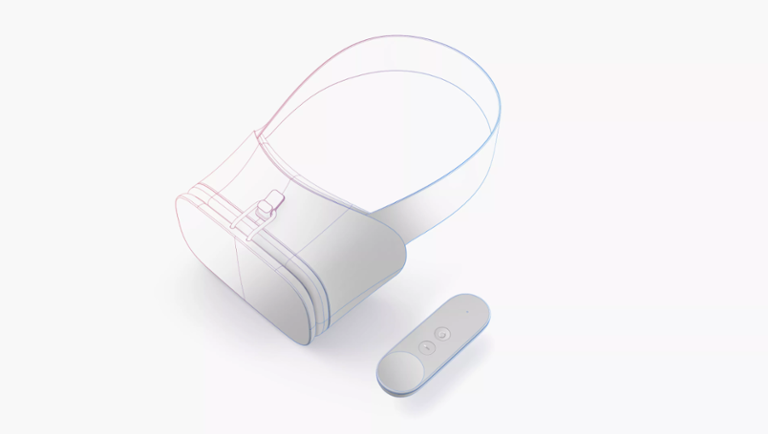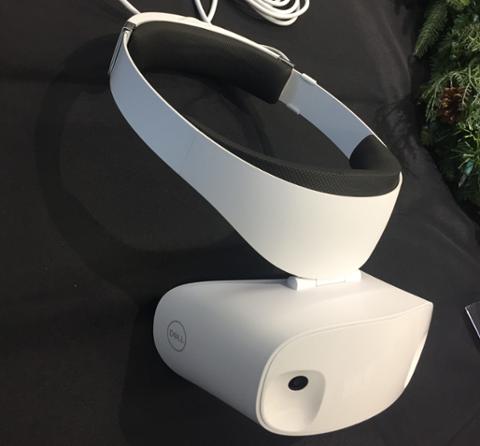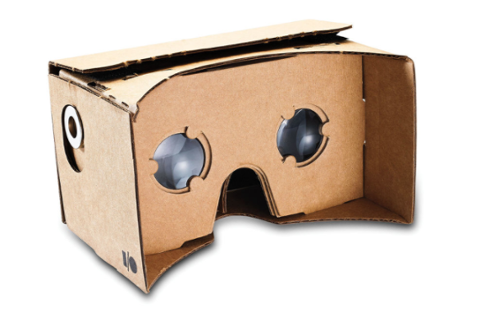 Not to be outdone by Microsoft or Facebook, Google plans to issue standalone virtual-reality (VR) headsets. As announced at this year’s I/O conference, Google is collaborating with hardware partners on the initiative, although details such as a precise release date went unmentioned onstage. Initial manufacturers HTC and Lenovo will apparently launch their respective versions before the end of the year. According to Backchannel, which released an extensive piece on Google’s VR efforts in conjunction with the I/O announcement, the headsets will cost “in the mid-hundreds range—similar to the higher-end VR rigs sold by Oculus and HTC.” Unlike the latter two devices, however, the Google version will not require a high-spec PC. “Yes, you get what you pay for,” the Backchannel story added. “The computation in these new devices is more akin to that of the phone than the supercomputer.” Last year, Google first unveiled its Daydream VR initiative. The first headset used a phone as a screen; Google may have hoped that public interest in VR would convince people to upgrade to its new Pixel smartphone, which was built with Daydream interoperability in mind. At the time, a variety of manufacturing partners—including LG and Samsung—suggested they would also support the Daydream initiative, although they haven’t exactly released a flood of compatible phones. Google’s decision to pursue a standalone VR headset could indicate several things. It may want to compete more directly against Oculus Rift and HTC Vive, which dominate the higher end of the VR market at the moment. Or perhaps the company is concerned about a lack of partner and developer involvement in phone-based VR, and thinks a new direction might help prod its ecosystem to life. There’s also the chance that Google, which is no stranger to trying out new things, simply wants to see if a standalone headset will sell. As with the initial Daydream launch, there’s the question of whether developers will want to build VR apps on Google’s platform. Google’s SDK for Daydream emerged from beta last fall; the company’s developer site now offers development kits for Android, Unity 3D, and Unreal. Those actually building a product also have guidelines they need to follow with regard to quality and distribution. And even if developers gravitate toward Google’s offerings, the company faces fresh competition from yet another tech giant newly interested in VR: Microsoft, which spent a portion of last week’s Build conference showing off its “mixed reality” headsets. Those devices, meant to deliver augmented reality (AR) experiences in addition to VR, will also hit the market later this year.
Not to be outdone by Microsoft or Facebook, Google plans to issue standalone virtual-reality (VR) headsets. As announced at this year’s I/O conference, Google is collaborating with hardware partners on the initiative, although details such as a precise release date went unmentioned onstage. Initial manufacturers HTC and Lenovo will apparently launch their respective versions before the end of the year. According to Backchannel, which released an extensive piece on Google’s VR efforts in conjunction with the I/O announcement, the headsets will cost “in the mid-hundreds range—similar to the higher-end VR rigs sold by Oculus and HTC.” Unlike the latter two devices, however, the Google version will not require a high-spec PC. “Yes, you get what you pay for,” the Backchannel story added. “The computation in these new devices is more akin to that of the phone than the supercomputer.” Last year, Google first unveiled its Daydream VR initiative. The first headset used a phone as a screen; Google may have hoped that public interest in VR would convince people to upgrade to its new Pixel smartphone, which was built with Daydream interoperability in mind. At the time, a variety of manufacturing partners—including LG and Samsung—suggested they would also support the Daydream initiative, although they haven’t exactly released a flood of compatible phones. Google’s decision to pursue a standalone VR headset could indicate several things. It may want to compete more directly against Oculus Rift and HTC Vive, which dominate the higher end of the VR market at the moment. Or perhaps the company is concerned about a lack of partner and developer involvement in phone-based VR, and thinks a new direction might help prod its ecosystem to life. There’s also the chance that Google, which is no stranger to trying out new things, simply wants to see if a standalone headset will sell. As with the initial Daydream launch, there’s the question of whether developers will want to build VR apps on Google’s platform. Google’s SDK for Daydream emerged from beta last fall; the company’s developer site now offers development kits for Android, Unity 3D, and Unreal. Those actually building a product also have guidelines they need to follow with regard to quality and distribution. And even if developers gravitate toward Google’s offerings, the company faces fresh competition from yet another tech giant newly interested in VR: Microsoft, which spent a portion of last week’s Build conference showing off its “mixed reality” headsets. Those devices, meant to deliver augmented reality (AR) experiences in addition to VR, will also hit the market later this year. Google Launching Standalone VR Headsets
 Not to be outdone by Microsoft or Facebook, Google plans to issue standalone virtual-reality (VR) headsets. As announced at this year’s I/O conference, Google is collaborating with hardware partners on the initiative, although details such as a precise release date went unmentioned onstage. Initial manufacturers HTC and Lenovo will apparently launch their respective versions before the end of the year. According to Backchannel, which released an extensive piece on Google’s VR efforts in conjunction with the I/O announcement, the headsets will cost “in the mid-hundreds range—similar to the higher-end VR rigs sold by Oculus and HTC.” Unlike the latter two devices, however, the Google version will not require a high-spec PC. “Yes, you get what you pay for,” the Backchannel story added. “The computation in these new devices is more akin to that of the phone than the supercomputer.” Last year, Google first unveiled its Daydream VR initiative. The first headset used a phone as a screen; Google may have hoped that public interest in VR would convince people to upgrade to its new Pixel smartphone, which was built with Daydream interoperability in mind. At the time, a variety of manufacturing partners—including LG and Samsung—suggested they would also support the Daydream initiative, although they haven’t exactly released a flood of compatible phones. Google’s decision to pursue a standalone VR headset could indicate several things. It may want to compete more directly against Oculus Rift and HTC Vive, which dominate the higher end of the VR market at the moment. Or perhaps the company is concerned about a lack of partner and developer involvement in phone-based VR, and thinks a new direction might help prod its ecosystem to life. There’s also the chance that Google, which is no stranger to trying out new things, simply wants to see if a standalone headset will sell. As with the initial Daydream launch, there’s the question of whether developers will want to build VR apps on Google’s platform. Google’s SDK for Daydream emerged from beta last fall; the company’s developer site now offers development kits for Android, Unity 3D, and Unreal. Those actually building a product also have guidelines they need to follow with regard to quality and distribution. And even if developers gravitate toward Google’s offerings, the company faces fresh competition from yet another tech giant newly interested in VR: Microsoft, which spent a portion of last week’s Build conference showing off its “mixed reality” headsets. Those devices, meant to deliver augmented reality (AR) experiences in addition to VR, will also hit the market later this year.
Not to be outdone by Microsoft or Facebook, Google plans to issue standalone virtual-reality (VR) headsets. As announced at this year’s I/O conference, Google is collaborating with hardware partners on the initiative, although details such as a precise release date went unmentioned onstage. Initial manufacturers HTC and Lenovo will apparently launch their respective versions before the end of the year. According to Backchannel, which released an extensive piece on Google’s VR efforts in conjunction with the I/O announcement, the headsets will cost “in the mid-hundreds range—similar to the higher-end VR rigs sold by Oculus and HTC.” Unlike the latter two devices, however, the Google version will not require a high-spec PC. “Yes, you get what you pay for,” the Backchannel story added. “The computation in these new devices is more akin to that of the phone than the supercomputer.” Last year, Google first unveiled its Daydream VR initiative. The first headset used a phone as a screen; Google may have hoped that public interest in VR would convince people to upgrade to its new Pixel smartphone, which was built with Daydream interoperability in mind. At the time, a variety of manufacturing partners—including LG and Samsung—suggested they would also support the Daydream initiative, although they haven’t exactly released a flood of compatible phones. Google’s decision to pursue a standalone VR headset could indicate several things. It may want to compete more directly against Oculus Rift and HTC Vive, which dominate the higher end of the VR market at the moment. Or perhaps the company is concerned about a lack of partner and developer involvement in phone-based VR, and thinks a new direction might help prod its ecosystem to life. There’s also the chance that Google, which is no stranger to trying out new things, simply wants to see if a standalone headset will sell. As with the initial Daydream launch, there’s the question of whether developers will want to build VR apps on Google’s platform. Google’s SDK for Daydream emerged from beta last fall; the company’s developer site now offers development kits for Android, Unity 3D, and Unreal. Those actually building a product also have guidelines they need to follow with regard to quality and distribution. And even if developers gravitate toward Google’s offerings, the company faces fresh competition from yet another tech giant newly interested in VR: Microsoft, which spent a portion of last week’s Build conference showing off its “mixed reality” headsets. Those devices, meant to deliver augmented reality (AR) experiences in addition to VR, will also hit the market later this year. 


